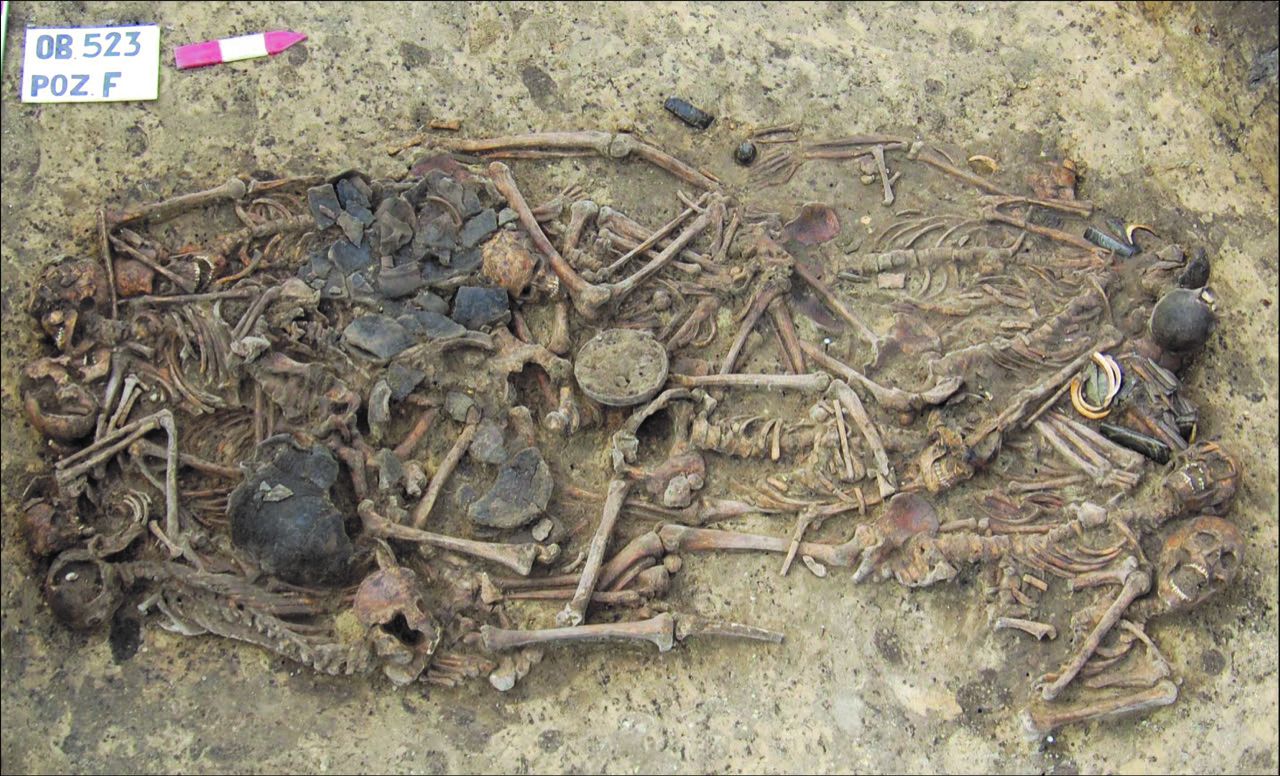
In 2011, archaeologists working in Poland made a grizzly discovery. A mass grave of 15 individuals—mostly women and children—that had been executed during a massacre. Scientists have now discovered that these 5,000-year-old murder victims were part of the same, extended family—and had been buried with great care, with mothers placed next to their children, and siblings by each others side.
By carrying out DNA analysis of the skeletons, researchers were able to build up a picture of the ancestry and kinship of those buried—and potentially identify the perpetrators of the violence. Findings are published in PNAS.
The mass grave, in Poland, is associated with the Globular Amphora culture, which existed in central Europe during the Bronze Age. The grave dates to between 2880-2776 BC—towards the end of the culture's existence.
At this time in Europe, another cultural group—the Corded Ware group—was expanding. Eventually, this culture would come to dominate a vast swath of Europe. The Globular Amphora and Corded Ware cultures would likely have crossed paths at some point—but what relations between the two groups were like is unclear.
In the latest study, scientists sequenced the genomes of all 15 skeletons. In the grave there were five adult females, four adult males, two girls and four boys. The youngest was a boy aged between 1.5 and two years at time of death. Analysis indicated they mostly had brown eyes, brown or dark blond hair and medium to dark skin.
They discovered the victims were part of a large extended family that was connected by several first and second degree relationships. In total, there were four families represented—mostly mothers and children. "Closely related kin were buried next to each other: A mother was buried cradling her child, and siblings were placed side by side," the scientists wrote. "Evidently, these individuals were buried by people who knew them well and who carefully placed them in the grave according to familial relationships."
None of the skeletons were found to be related to members of the Corded Ware group.
The team also looked at the injuries the individuals had suffered. All were found to have injuries to the skull that appear to have been inflicted at time of death, suggesting they were killed by blows to the head. "Overall, the nature of the injuries and the near absence of so-called parry fractures (i.e., injuries sustained to the upper limbs) suggest that the individuals were captured and executed, rather than killed in hand-to-hand combat," the team wrote.
Scientists suggest that the individuals in the grave were killed in a massacre when men from the group were absent. This massacre could have been carried out by members of the Corded Ware group during the expansion—although the authors say reasons for the attack are not clear.
"Brutal events such as the family massacre documented in the Koszyce burial may have been all too common in the unstable, tumultuous centuries at the beginning of the third millennium BC," the study concludes. "However, along with all the violence and aggression illustrated by the Koszyce find, our study also demonstrates the strong sense of family affiliation and cohesion that prevailed among this group of people. From the careful positioning of the bodies in the grave, it is clear that both nuclear and extended family relations were key to how people organized their lives, and that these relations represented major, normative values in Globular Amphora communities of this period."
Uncommon Knowledge
Newsweek is committed to challenging conventional wisdom and finding connections in the search for common ground.
Newsweek is committed to challenging conventional wisdom and finding connections in the search for common ground.
About the writer
Hannah Osborne is Nesweek's Science Editor, based in London, UK. Hannah joined Newsweek in 2017 from IBTimes UK. She is ... Read more
To read how Newsweek uses AI as a newsroom tool, Click here.








